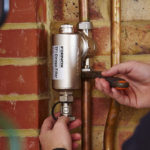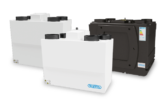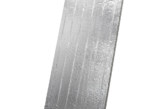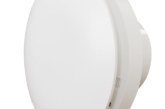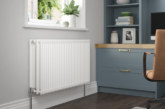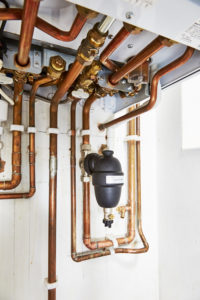 Carl Allinson, UK and Ireland Sales Director at Fernox, looks at the benefits of including an inline filter on the specification of the central heating system in new build properties.
Carl Allinson, UK and Ireland Sales Director at Fernox, looks at the benefits of including an inline filter on the specification of the central heating system in new build properties.
Buyers of new build homes will be very conscious of issues with their property during the first weeks and months of ownership. This is especially true when it comes to an area as important – and costly to repair – as the central heating and hot water system. For this reason, ensuring the system is fully protected from day one is essential to avoid issues with recently sold properties. Best practice is to use a combination of high quality chemical water treatment to prevent corrosion and an in-line filter to capture and remove magnetic and non-magnetic debris.
Why protect a new system?
While sludge, scale and contamination are often associated with older systems, new installations are also vulnerable, and without protection can begin to suffer damage and reduced efficiency in a matter of weeks. One problem common in new systems is the presence of flux and solder residues following installation. If these contaminants are allowed to circulate freely, they can damage components of the boiler and prematurely shorten its lifespan.
When water comes into contact with metal within the system, a chemical reaction called electrolytic corrosion begins to occur. Over time this produces iron oxide deposits and sludge. These can circulate and coat internal components with the thick, sticky paste magnetite. Limescale is also an issue, particularly in hard water areas of 200ppm and above, and can form on surfaces within the system, including vital components such as the heat exchanger or pump.
If not addressed quickly, contamination results in poor system performance, radiator cold spots and causes the boiler to work harder to reach the required temperature. British Water estimates that just a 1.6mm coating of limescale on a heating element can reduce boiler efficiency by up to 12%. This not only increases the fuel costs for the homeowner, but it will also reduce the lifespan of the boiler through premature breakdown.
Even the most efficient, ‘A’ rated boilers will only achieve this level of performance if the system is kept free of contamination. Ensuring the correct level of protection is often more crucial with modern boilers which have been reduced in size in order to make space and efficiency improvements; the miniaturisation of boilers has resulted in narrower waterways and channels, which can more easily become blocked by any circulating debris, sludge or scale.
Inhibitor
All new central heating systems and boilers must be pre-commissioned and compliant with Part L of the Building Regulations. This includes correctly dosing the system with an inhibitor to prevent the build-up of corrosion and limescale. When selecting an inhibitor, it is important to use a product certified by NSF International, which demonstrates that it meets or exceeds the required quality standards.
It is also recommended that a filter is installed on every system – an approach that is advocated within the supplementary information of the Domestic Heating Guide, which states: “a filter can also be fitted to the central heating circuit to help maintain the efficiency and reliability of the system.”
A high-quality system filter provides protection that complements the chemical water treatment. It will capture and contain debris and sludge, preventing it from collecting in the pipework of the system or reaching the boiler. The contaminants can be safely and easily removed during scheduled annual boiler service.
Magnetic attraction
However, it is important to consider the choice of filter to ensure the best possible levels of protection. Selecting a filter that will remove both magnetic and non-magnetic debris is important. For example, the Fernox TF1 Omega and TF1 Sigma Filters use both a powerful Neodymium magnet and a unique Hydronic Particle Separation (HPS) technology. This works by reducing the velocity of the suspended particles, allowing the debris to settle at the bottom of the filter for quick and safe removal.
Installation flexibility is crucial for housebuilders, to optimise the use of space in all areas of the property. Smaller more compact filters that can be installed on vertical or horizontal pipework or even positioned at a 45° angle, as per the TF1 filter range from Fernox, are ideal.
Finally, lidless, sealed filters are also an intelligent choice to eliminate the risk of issues with the heating system and to aid the cleaning and servicing process at the annual boiler service. On lidded filters, an ‘O’ ring sits between the filter body and the lid to ensure a tight seal. However, after the cleaning process – where it is necessary to remove the lid – the ‘O’ ring must be replaced each time the lid is removed to prevent the possibility of leaks.
This adds installer time at each service and the overall cost of servicing the filter over its lifespan.

